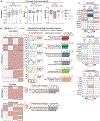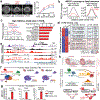A transcriptional switch governs fibroblast activation in heart disease
- PMID: 34163071
- PMCID: PMC8341289
- DOI: 10.1038/s41586-021-03674-1
A transcriptional switch governs fibroblast activation in heart disease
Abstract
In diseased organs, stress-activated signalling cascades alter chromatin, thereby triggering maladaptive cell state transitions. Fibroblast activation is a common stress response in tissues that worsens lung, liver, kidney and heart disease, yet its mechanistic basis remains unclear1,2. Pharmacological inhibition of bromodomain and extra-terminal domain (BET) proteins alleviates cardiac dysfunction3-7, providing a tool to interrogate and modulate cardiac cell states as a potential therapeutic approach. Here we use single-cell epigenomic analyses of hearts dynamically exposed to BET inhibitors to reveal a reversible transcriptional switch that underlies the activation of fibroblasts. Resident cardiac fibroblasts demonstrated robust toggling between the quiescent and activated state in a manner directly correlating with BET inhibitor exposure and cardiac function. Single-cell chromatin accessibility revealed previously undescribed DNA elements, the accessibility of which dynamically correlated with cardiac performance. Among the most dynamic elements was an enhancer that regulated the transcription factor MEOX1, which was specifically expressed in activated fibroblasts, occupied putative regulatory elements of a broad fibrotic gene program and was required for TGFβ-induced fibroblast activation. Selective CRISPR inhibition of the single most dynamic cis-element within the enhancer blocked TGFβ-induced Meox1 activation. We identify MEOX1 as a central regulator of fibroblast activation associated with cardiac dysfunction and demonstrate its upregulation after activation of human lung, liver and kidney fibroblasts. The plasticity and specificity of BET-dependent regulation of MEOX1 in tissue fibroblasts provide previously unknown trans- and cis-targets for treating fibrotic disease.
© 2021. The Author(s), under exclusive licence to Springer Nature Limited.
Figures
















Comment in
-
MEOX1: a novel druggable target that orchestrates the activation of fibroblasts in cardiac fibrosis.Signal Transduct Target Ther. 2021 Dec 24;6(1):440. doi: 10.1038/s41392-021-00842-7. Signal Transduct Target Ther. 2021. PMID: 34952898 Free PMC article. No abstract available.
References
-
- Rockey DC, Bell PD & Hill JA Fibrosis--A Common Pathway to Organ Injury and Failure. N. Engl. J. Med 373, 96 (2015). - PubMed
Publication types
MeSH terms
Substances
Grants and funding
- R01 HL127240/HL/NHLBI NIH HHS/United States
- K08 HL157700/HL/NHLBI NIH HHS/United States
- R01 HL147558/HL/NHLBI NIH HHS/United States
- R01 HL150521/HL/NHLBI NIH HHS/United States
- R01 HL150100/HL/NHLBI NIH HHS/United States
- R01 HL057181/HL/NHLBI NIH HHS/United States
- R01 HL139783/HL/NHLBI NIH HHS/United States
- R01 MH123178/MH/NIMH NIH HHS/United States
- P01 HL089707/HL/NHLBI NIH HHS/United States
- U01 HL098179/HL/NHLBI NIH HHS/United States
- R01 HL116848/HL/NHLBI NIH HHS/United States
- P01 HL146366/HL/NHLBI NIH HHS/United States
- UM1 HL098179/HL/NHLBI NIH HHS/United States
- F32 HL147463/HL/NHLBI NIH HHS/United States
- R01 HL150225/HL/NHLBI NIH HHS/United States
- C06 RR018928/RR/NCRR NIH HHS/United States
- R01 HS015100/HS/AHRQ HHS/United States
- R01 DK119594/DK/NIDDK NIH HHS/United States
LinkOut - more resources
Full Text Sources
Other Literature Sources
Medical
Molecular Biology Databases

